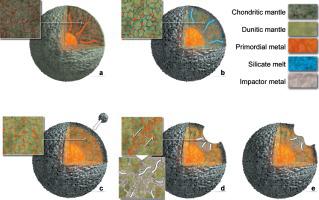当前位置:
X-MOL 学术
›
Earth Planet. Sci. Lett.
›
论文详情
Our official English website, www.x-mol.net, welcomes your
feedback! (Note: you will need to create a separate account there.)
Two-stage formation of pallasites and the evolution of their parent bodies revealed by deformation experiments
Earth and Planetary Science Letters ( IF 4.8 ) Pub Date : 2020-09-01 , DOI: 10.1016/j.epsl.2020.116419 Nicolas P. Walte , Giulio F.D. Solferino , Gregor J. Golabek , Danielle Silva Souza , Audrey Bouvier
Earth and Planetary Science Letters ( IF 4.8 ) Pub Date : 2020-09-01 , DOI: 10.1016/j.epsl.2020.116419 Nicolas P. Walte , Giulio F.D. Solferino , Gregor J. Golabek , Danielle Silva Souza , Audrey Bouvier

|
Abstract Pallasites, stony-iron meteorites predominantly composed of olivine crystals and Fe-Ni metal, are samples of the interior of early solar system bodies and can thus provide valuable insights into the formation of terrestrial planets. However, pallasite origin is controversial, either sampling the core-mantle boundary or the shallower mantle of planetesimals that suffered an impact. We present high strain-rate deformation experiments with the model system olivine + FeS melt ± gold melt to investigate pallasite formation and the evolution of their parent bodies and compare the resulting microstructures to two samples of Seymchan pallasite. Our experiments reproduced the major textural features of pallasites including the different olivine shapes, olivine aggregates, and the distribution of the metal and sulfide phases. These results indicate that pallasites preserve evidence for a two-stage formation process including inefficient core-mantle differentiation and an impact causing disruption, metal melt injection, and fast cooling within months to years. Olivine aggregates, important constituents of angular pallasites, are reinterpreted as samples of a partially differentiated mantle containing primordial metallic melt not stemming from the impactor. The long-term retention of more than 10 vol% of metal melt in a silicate mantle sampled by olivine aggregates indicates high effective percolation thresholds and inefficient metal-silicate differentiation in planetesimals not experiencing a magma ocean stage.
中文翻译:

变形实验揭示的两阶段形成及其母体演化
摘要 Pallasites 是主要由橄榄石晶体和 Fe-Ni 金属组成的石铁陨石,是早期太阳系天体内部的样本,因此可以提供对类地行星形成的宝贵见解。然而,橄榄石起源是有争议的,要么是在核-地幔边界取样,要么是对受到撞击的星子的较浅地幔进行取样。我们使用模型系统橄榄石 + FeS 熔体 ± 金熔体进行高应变率变形实验,以研究橄榄石的形成及其母体的演化,并将所得微观结构与两个 Seymchan 橄榄石样品进行比较。我们的实验再现了橄榄石的主要结构特征,包括不同的橄榄石形状、橄榄石聚集体以及金属和硫化物相的分布。这些结果表明,橄榄岩保留了两阶段形成过程的证据,包括低效的核-地幔分化和导致破坏、金属熔体注入和数月至数年内快速冷却的撞击。橄榄石聚集体是角陨石的重要成分,被重新解释为部分分化的地幔样本,其中包含并非来自撞击器的原始金属熔体。橄榄石聚集体采样的硅酸盐地幔中长期保留超过 10 vol% 的金属熔体表明,在没有经历岩浆海洋阶段的微星中,有效的渗透阈值和金属硅酸盐分化效率低下。金属熔体注射,并在数月至数年内快速冷却。橄榄石聚集体是角陨石的重要成分,被重新解释为部分分化的地幔样本,其中包含并非来自撞击器的原始金属熔体。橄榄石聚集体采样的硅酸盐地幔中长期保留超过 10 vol% 的金属熔体表明,在没有经历岩浆海洋阶段的微星中,有效的渗透阈值和金属硅酸盐分化效率低下。金属熔体注射,并在数月至数年内快速冷却。橄榄石聚集体是角陨石的重要组成部分,被重新解释为部分分化的地幔样本,其中包含并非来自撞击器的原始金属熔体。橄榄石聚集体采样的硅酸盐地幔中长期保留超过 10 vol% 的金属熔体表明,在没有经历岩浆海洋阶段的微星中,有效的渗透阈值和金属硅酸盐分化效率低下。
更新日期:2020-09-01
中文翻译:

变形实验揭示的两阶段形成及其母体演化
摘要 Pallasites 是主要由橄榄石晶体和 Fe-Ni 金属组成的石铁陨石,是早期太阳系天体内部的样本,因此可以提供对类地行星形成的宝贵见解。然而,橄榄石起源是有争议的,要么是在核-地幔边界取样,要么是对受到撞击的星子的较浅地幔进行取样。我们使用模型系统橄榄石 + FeS 熔体 ± 金熔体进行高应变率变形实验,以研究橄榄石的形成及其母体的演化,并将所得微观结构与两个 Seymchan 橄榄石样品进行比较。我们的实验再现了橄榄石的主要结构特征,包括不同的橄榄石形状、橄榄石聚集体以及金属和硫化物相的分布。这些结果表明,橄榄岩保留了两阶段形成过程的证据,包括低效的核-地幔分化和导致破坏、金属熔体注入和数月至数年内快速冷却的撞击。橄榄石聚集体是角陨石的重要成分,被重新解释为部分分化的地幔样本,其中包含并非来自撞击器的原始金属熔体。橄榄石聚集体采样的硅酸盐地幔中长期保留超过 10 vol% 的金属熔体表明,在没有经历岩浆海洋阶段的微星中,有效的渗透阈值和金属硅酸盐分化效率低下。金属熔体注射,并在数月至数年内快速冷却。橄榄石聚集体是角陨石的重要成分,被重新解释为部分分化的地幔样本,其中包含并非来自撞击器的原始金属熔体。橄榄石聚集体采样的硅酸盐地幔中长期保留超过 10 vol% 的金属熔体表明,在没有经历岩浆海洋阶段的微星中,有效的渗透阈值和金属硅酸盐分化效率低下。金属熔体注射,并在数月至数年内快速冷却。橄榄石聚集体是角陨石的重要组成部分,被重新解释为部分分化的地幔样本,其中包含并非来自撞击器的原始金属熔体。橄榄石聚集体采样的硅酸盐地幔中长期保留超过 10 vol% 的金属熔体表明,在没有经历岩浆海洋阶段的微星中,有效的渗透阈值和金属硅酸盐分化效率低下。










































 京公网安备 11010802027423号
京公网安备 11010802027423号